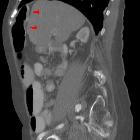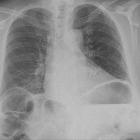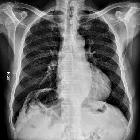Chilaiditi syndrome












Chilaiditi syndrome is the anterior interposition of the colon to the liver reaching the under-surface of the right hemidiaphragm with associated upper abdominal pain; it is one of the causes of pseudopneumoperitoneum.
Colonic gas in this position may be misinterpreted as true pneumoperitoneum resulting in further imaging, investigation, and treatment that is not required.
Pain distinguishes Chilaiditi syndrome from asymptomatic colonic interposition, which is termed as Chilaiditi sign. This is by virtue of the fact that syndrome is a collection of signs and symptoms.
Radiographic features
Plain radiograph
Features that suggest a Chilaiditi syndrome (i.e. Chilaiditi sign) include:
- gas between the liver and diaphragm
- haustra within the gas suggesting that it is within the bowel and not free
CT
If there is a clinical suspicion of abdominal visceral perforation and plain radiographic appearances are unclear, abdominal CT can be performed to clarify whether there is pneumoperitoneum.
CT can clearly demonstrate the presence of interposed colonic loops between the right hemidiaphragm and liver with no free intraperitoneal air.
Treatment and prognosis
Asymptomatic patients with Chilaiditi syndrome do not require specific treatment. Those with abdominal pain or distension are usually treated conservatively with analgesia and fluid resuscitation. Patients with recurrent presentations or evidence of bowel ischemia may be offered surgical treatment. Gangrenous or ischemic bowel segments may have to be removed if there is associated colonic volvulus. Otherwise, colopexy may be sufficient to prevent future recurrence of symptoms.
History and etymology
It is named after Demetrius Chilaiditi (1883-1975) , Greek radiologist who described the radiographic findings in 1910 whilst working in Vienna, Austria. Although the first description of the interposition of colon between the liver and the right hemidiaphragm was published by Cantini in 1865 .
Siehe auch:
und weiter:

 Assoziationen und Differentialdiagnosen zu Chilaiditisyndrom:
Assoziationen und Differentialdiagnosen zu Chilaiditisyndrom:

